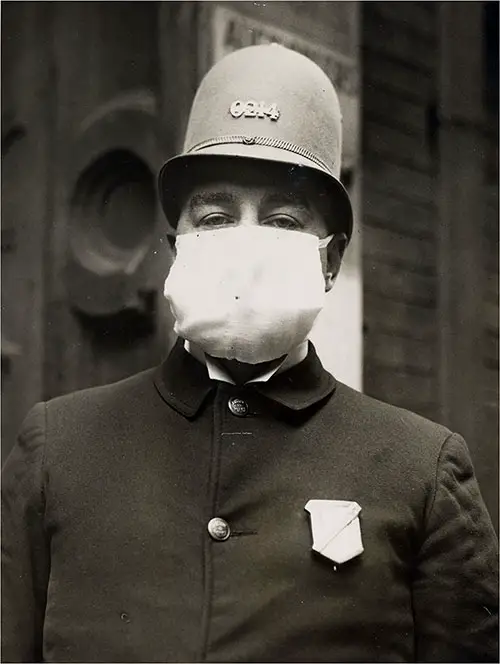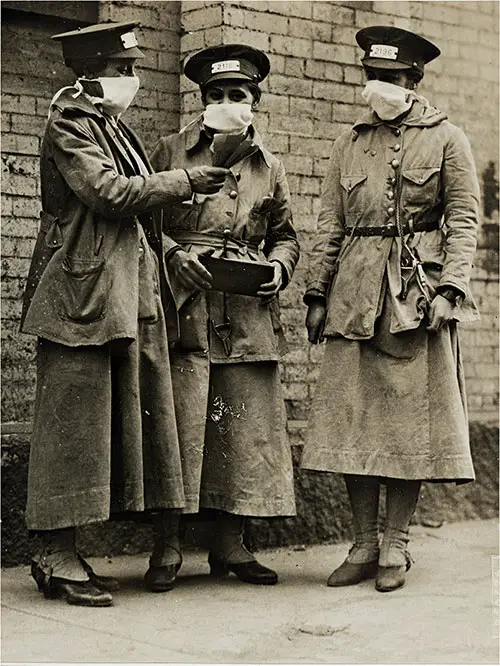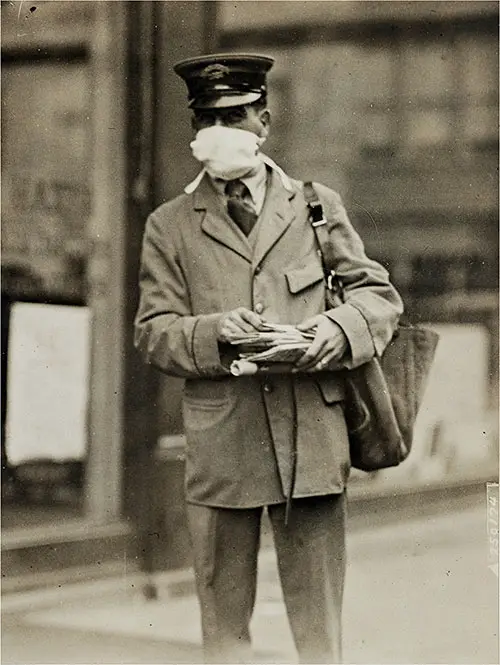How Influenza Got In - 1918

Police Officer Wears Mask for Protection Against Influenza, 7 October 1918. 1700 of these Masks were Distributed by Policemen to Police Stations, to be Used Whenever Duty Calls. Photograph © International Film Service, New York. National Archives and Records Administration RG 165-WW-269B-30. NARA ID # 45499349. GGA Image ID # 150d626a5d
Influenza Does Not Arise; it travels. It reached the United States by crossing the Atlantic, and it would seem that it might have been kept out. This is, in fact, the editorial opinion of The Scientific American (New York, November 2), which under the heading "A carelessly Guarded Gate," charges that the laxity of port authorities on our Eastern coast is responsible for an invasion that has caused more deaths among peaceful citizens than the deadly weapons of the enemy have effected on the front of the battle.
Instead of establishing a rigid quarantine, the authorities seem to have ignored the infectious character of the disease and placed its victims in the open wards of hospitals, where it quickly spread.
This all took place in the land of Gorgas, whose people can tame a fever-infected swamp one day and then calmly take disease to their own bosoms the next! Says the paper named above:
"There is a growing conviction that the sudden invasion of the United States by that European epidemic known as Spanish influenza, and the speed with which it has spread throughout the country, are due to the laxity with which the port authorities along the Atlantic seaboard have carried out their duties…
"If ever there was a period when the quarantine laws for guarding the ports of the United States against the entrance of disease should have been enforced with redoubled vigilance, it was during the summer and autumn of the present year, when it was known that a highly infectious and fatal disease was sweeping through Europe like a scourge of the Middle Ages.
Facial Armor for The Influenza

New York City Conductorettes Wearing Masks for Protection Against Influenza. Photograph © Underwood & Underwood, NY. Taken 16 October 1918. National Archives and Records Administration RG 165-WW-269B-17. NARA ID # 45499323. GGA Image ID # 15080552dc
This plague has caused "more casualties and deaths in the homeland than occurred among our troops in the great world-war." Over 82,000 deaths were attributed to influenza and pneumonia between September 8 and November 9, according to reports from forty-six large cities with a combined population of 23,000,000. The estimate of deaths from all causes in the American Expeditionary Forces is 40,000.

New York City Letter Carrier Wears Protective Mask During Influenza Epidemic. Photograph © Underwood & Underwood Taken 16 October 1918. National Archives and Records Administration RG 165-WW-269B-15. NARA ID # 45499319. GGA Image ID # 1507e95367
"In view of the imminence and deadly character of the disease, we had every reason to expect that the Federal authorities would set a double guard at our ports of entry, and instruct our quarantine officials to take every possible preventive measure against the landing, not merely of influenza patients, but of every passenger who had been exposed, during the ocean voyage, to infection.
"Nor can any carelessness be excused on the ground that influenza has never been classed with the deadly diseases, such as yellow fever or the bubonic plague. While such an excuse might be valid for the layman, it cannot be allowed in the case of the expert professional men, whose duty it is to enforce the quarantine laws-of the country.
"For they know full well that this was no ordinary epidemic of influenza or grip. The medical records of Europe were available; and the most cursory reading of the data that have appeared in the medical journals (to go no further than that) should have revealed to these men that here was a disease the exclusion of which from America called for the most exacting and rigid enforcement of the quarantine laws.
"The obvious thing to have done, when the first ship with influenza patients on board cast anchor at a quarantine station, was to isolate that ship, with every soul on board, until the slightest possibility of carrying infection ashore had been removed"
The rigid precautions that would be taken, if an arriving ship had yellow-fever patients aboard, should surely have been taken in the case of this deadly scourge.
"But what are the facts? Incredible as it may seem, influenza cases by the score and, for all we know, by the hundred, were taken ashore and placed in the general wards of the hospitals.
"Fellow passengers of the patients, who must inevitably have been exposed to infection, and must many of them have been carrying the disease, were allowed to go their several ways throughout the land.
"Was ever official fatuity stretched to greater lengths than this!
"When once the ship's company had scattered, whether to spread the infection among fellow patients in a general hospital, or among the unsuspecting and unwarned. citizens in home, office, passenger-car, or theater, the mischief was done.
"But even when the plague burst forth in all its wide-spread malignity, both New York and the country at large seemed slow to awaken to the enormity of the peril. Only here and there did the authorities act with swift and effective measures, closing schools, theaters, and public meeting-places.
"It is certainly a disconcerting fact that, at the very time when the country had organized itself, through the Red Cross and other famous organizations, to fight disease and prevent suffering, we should be smitten with a visitation which caused more casualties and deaths in the homeland than occurred among our troops in the great world-War."
"How Influenza Got In," in The Literary Digest, New York: Funk & Wagnalls, Vol. LIX, No. 9, Whole No. 1493, 30 November 1918, p. 23.
